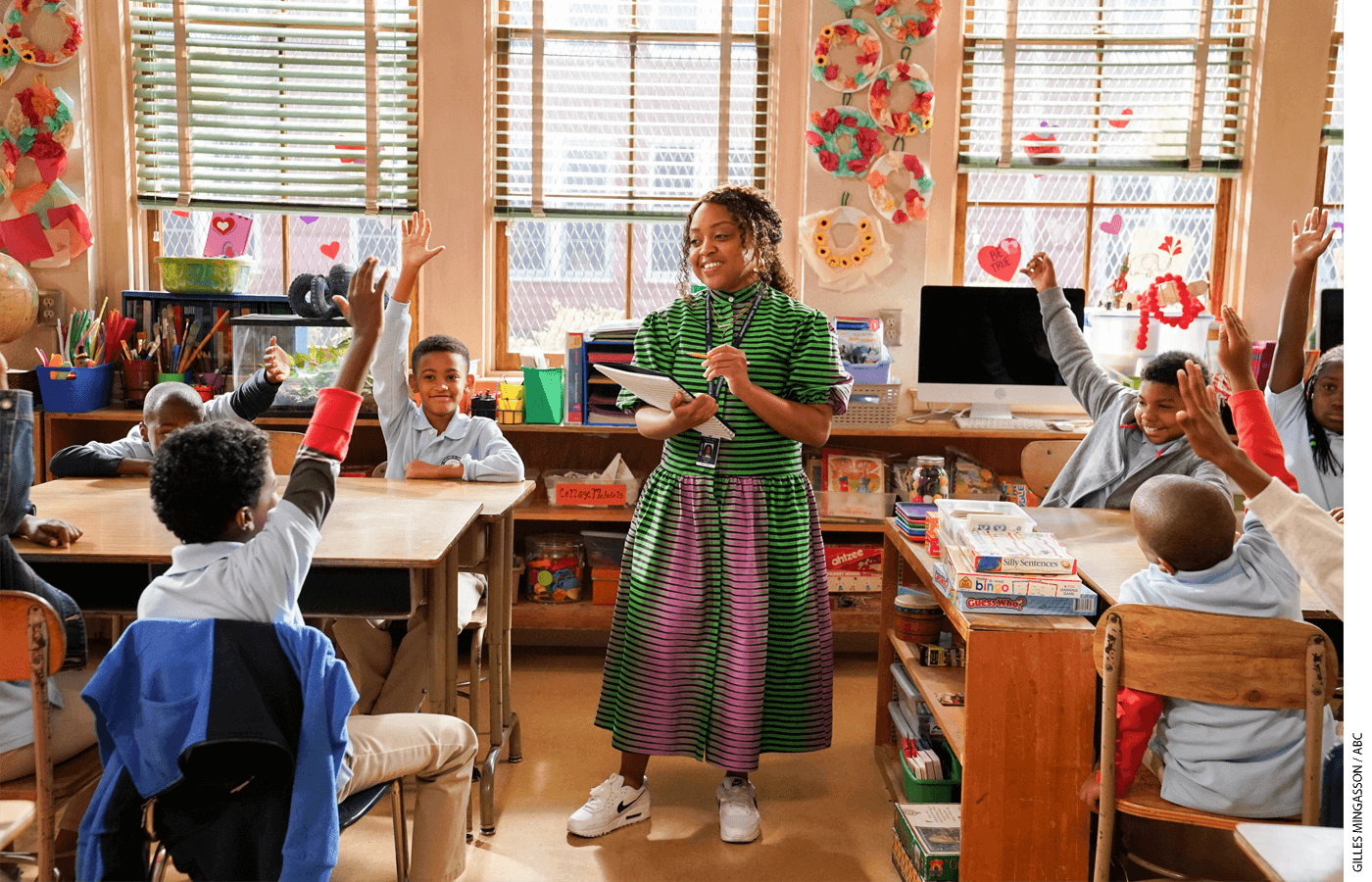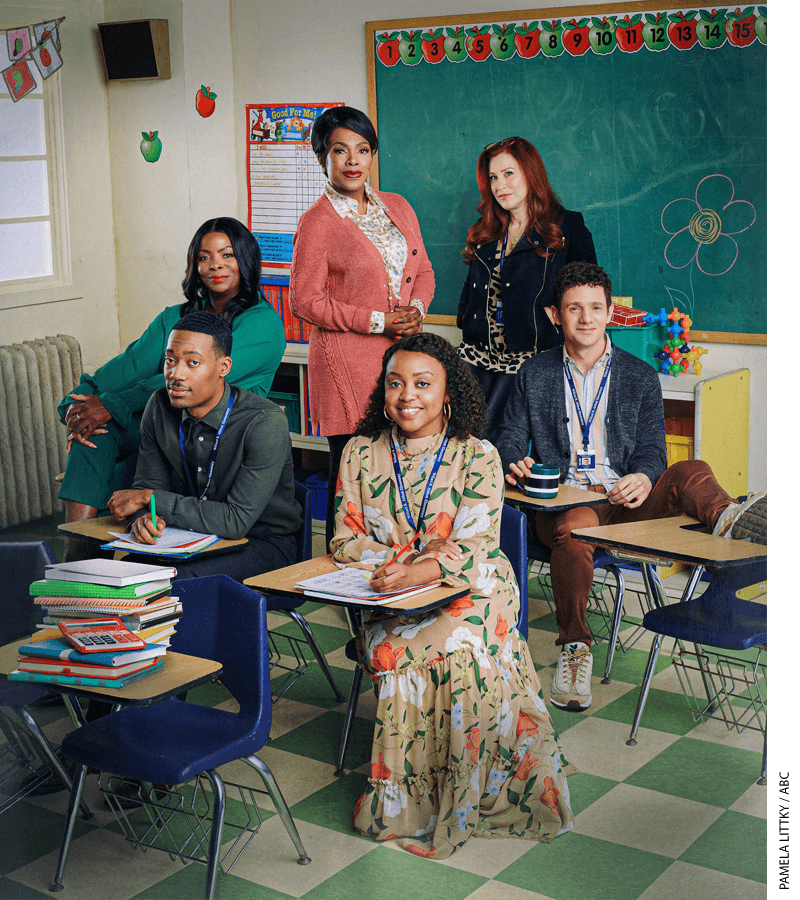
Folks in education policy and practice often obsess over whether pop-culture depictions of school life are accurate. But they aren’t, even when they try to be. How plausible is it, for example, that “Prez,” the hot-headed and impulsive rookie cop in HBO’s gritty drama The Wire, accidentally kills a fellow police officer during a botched undercover operation yet somehow still gets hired and finds redemption as a compassionate and dedicated Baltimore public school teacher?
Worse, when the favorite reforms and policy plays of education reformers are skewered by the entertainment-industrial complex, we react as though the takedown carries the weight of an executive order. When John Oliver did an anti-charter school exposé on HBO’s Last Week Tonight, it was as if he were not a comedian but the reincarnation of Edward R. Murrow himself, who famously denounced Joe McCarthy on See It Now. When I asked one high-profile ed reformer why she was treating a comedy show as an existential threat to her work, she sternly replied, “This is where people get their news!” Well, then, people are fools.
This brings us to the latest pop culture artifact to inspire sturm und drang over the policy ramifications of its setting, characters, story arc, and political point of view. Abbott Elementary is a television sitcom created by Quinta Brunson, who also plays the lead as teacher Janine Teagues. The show, which premiered on ABC in December 2021, revolves around the daily lives of the teachers and staff of a fictitious public school in Philadelphia. It has been widely praised for its witty portrayal of life in an urban school, attracted millions of viewers, and won three Emmy awards.
The show is set in Abbott Elementary School, located in a working-class neighborhood of Philadelphia and beset by the standard litany of features associated in the public imagination with struggling inner-city schools: lack of funding, outdated equipment, and a staff that is overworked and underpaid. Despite these obstacles, the teachers and staff are (naturally) dedicated to making a difference in the lives of their students.
Brunson herself is aware of the limitations of her creation and seems almost embarrassed by the attention it’s received among educators. “I know it sounds bad, but a lot of people are like, ‘Wow, you did this thing to show how under-appreciated teachers are, to change the world,’” she said at a TV industry panel discussion last year. “Not really. I really just wanted to make a good workplace comedy.”
So, does Abbott Elementary get the details right?
No, of course not! Am I mumbling? It’s not an ethnography of an inner-city school; it’s a network sitcom, for Pete’s sake! Are you serious?! When the script requires teachers to talk to one another, which they do constantly, they don’t think twice about leaving their classrooms unattended. For all their complaining about never having time to prepare lessons, they spend an awful lot of time hanging out in the faculty lounge and chatting in the hallway. The main characters teach a range of grade levels, from kindergarten to the upper grades, yet somehow, they all seem to have the same lunch period. On staff development days, the room is filled with extras, suggesting the school has a large faculty. Yet when a charter school peels away some 3rd-grade students, Abbott’s 2nd grade teacher is forced to teach both grades in a single classroom. Children are little more than set dressing on Abbott Elementary and they only rarely speak (yeah, right). In my Bronx 5th grade classroom, I had students as old as 12 and 13, but some of the upper-grade Abbott kids look old enough to drive.

The show’s idea of a “disruptive student” is a child who calls out off-topic references to a TV show in class while his classmates are sitting in rapt attention to the teacher’s science lesson (on TV, teachers are still the “sage on the stage,” not the “guide on the side”). It’s the kind of mild misbehavior that calls for “planned ignoring” at best and likely wouldn’t even merit a teacher’s attention in an actual classroom, let alone become fodder for a storyline. The child is sent to the office of the principal, a vain, self-absorbed, and ineffective figure who commands little respect from her staff. When she sends the child back to class with a toy, the rest of the class erupts. That’s his punishment? Now they, too, want to be sent to the principal’s office.
OK, so that part is realistic. Nailed it.
A major plotline in the second season of Abbott Elementary involves a charter school that opens nearby. Naturally, this sent the commentariat into overdrive for an inevitable round of plumbing light entertainment for important political messages. The New Yorker devoted several pages in a March issue to a discussion of how Brunson’s “superb sitcom became an unabashed polemic against the privatization of a public good.”
Must we? Really? Very well, if we are going to take our public-policy cues from a network sitcom and fact-check the script, let the record show that charter schools are public schools, not private; they do not hand-pick high-performing kids, nor can they kick them out for struggling academically. The Abbott crew mistakenly receives a box of textbooks meant for Addington, the gleaming new charter down the block run by Legendary Charter Schools. When they deliver the books to snoop on the upstart school, they run into a former Abbott teacher who was let go for kicking a student. “I don’t do that anymore. Anger management,” the charter-school teacher chirps brightly, then adds in a conspiratorial stage whisper, “At a charter school there’s a lot less oversight in the hiring process. So, it’s been pretty sweet.”
Abbott Elementary does drop the occasional hint that traditional public education, too, is something less than an unalloyed civic good. When Brunson’s earnest and adorable main character, Janine, wants to paint her classroom to match the look and feel of Addington, the principal stops her because that would run afoul of the rules laid down by “the Philadelphia Department of Education, Animal Shelters, and Traffic.” A veteran teacher tells a young colleague to take down a schedule he created to ensure the school’s new curriculum gets taught. “Being a teacher is being asked to do the impossible, year after year,” she tells him, “and our only solution is to show up every day and try our best.” It’s meant to be maternal advice, but it could just as easily land as low expectations. On Reddit, real-life teachers have expressed disapproval at the sins the show commits against the science of reading: the three-cueing method of instruction debunked in Emily Hanford’s Sold a Story podcast lives on at Abbott Elementary.
The most unrealistic touch of all is Abbott itself. If neighborhood public schools were filled with the funny, likable, and dedicated teachers of Abbott Elementary, there would be no charter schools. Addington is filled with new books, French classes, a new computer lab, and more—in contrast to Abbott, which (you know how this sentence is going to end) is “underfunded,” not badly managed. Still, if charter advocates are looking for retribution for the sins committed against their sector by Abbott Elementary, they can start and finish with the Philadelphia public school system, where only a third of students in grades 3 to 8 met reading standards in the 2021–22 school year. And that was robust compared to math, where just 17 percent were up to snuff. According to data released in May by the district, three out of four Philly schools met between zero and 33 percent of their academic targets for the school year, which is no laughing matter.
Abbott Elementary plays to the conventional notions of those outside the edusphere and mines for laughs many of the standard myths and homilies of teaching. The city predicts the prison population based on reading performance. Barbara, a wise veteran, tells her young and earnest colleagues, “Your students can either fear you or respect you.” Sending a kid to the principal’s office makes a young white teacher, an awkward and clueless newbie whom savvy viewers will recognize as a Teach For America tintype, feel like “the mayor of White Guiltsylvania.”
But don’t blame the lack of sophistication on Brunson and company. They’re actors, writers, and comedians, not ed policy people. They’ve created a slight but amusing enough workplace comedy whose major faults lie not in its portrayal of an urban elementary school, but in the irritating tics TV viewers have come to associate with other workplace comedies, such as The Office, on which it’s modeled: the “mockumentary” style of rapid shifts and zooms, and characters breaking the fourth wall and shooting knowing glances at the camera to land weak jokes that even the writers seem to know merit more smirks than belly laughs.
As a kid, I watched an ungodly amount of television. Columbo and The Streets of San Francisco made detective work look fascinating. And every Saturday night, Emergency! made working as a paramedic seem like one exciting adventure after the next. Welcome Back, Kotter, though, didn’t make me want to be a teacher. The “Sweathogs” in that sitcom’s remedial ed classroom reminded me a little too much of the tough kids who mocked and intimidated me in metal shop. The point is, a lot of us form our ideas about various occupations from television shows—and most of these impressions are far from realistic.
But television is meant for entertainment, not elucidation. And know—as always—that when those of us in the education arena argue over whether a TV show is true-to-life or not, accurate or mythologizing, it’s a telltale sign of motivated reasoning: “Abbott Elementary reminds me so much of the teachers I know!” (Read: pay us more). “That’s not what it’s like at all!” (Read: open more charter schools). It’s just a television show. If every district-run school in Philadelphia were like Abbott Elementary, you wouldn’t put your kid in a charter. Or teach in one.
Robert Pondiscio is a senior fellow at the American Enterprise Institute and author of How the Other Half Learns (Avery, 2019).
This article appeared in the Fall 2023 issue of Education Next. Suggested citation format:
Pondiscio, R. (2023). Does Abbott Elementary Get Teaching in an Inner-City Public School Right? Entertainment, not elucidation. Education Next, 23(4), 56-59.


